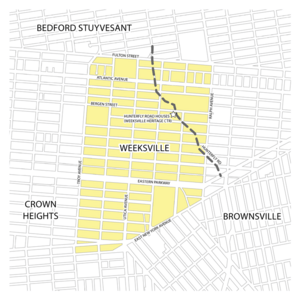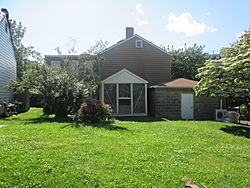Weeksville, Brooklyn facts for kids
Weeksville is a special historic neighborhood in Brooklyn, New York. It was started a long time ago by free African Americans. Today, this area is part of the Crown Heights neighborhood.
Contents
How Weeksville Began
Weeksville is named after a man named James Weeks. He was an African American who worked on ships, loading and unloading cargo. In 1838, New York State had already ended slavery. James Weeks bought a piece of land in Brooklyn. He bought it from another free African American man named Henry C. Thompson.
Many people saw buying land as a way to gain freedom and build their own communities. Weeksville became a place where African Americans could own property and have a voice.
The village was created by a group of African American land owners and activists. It covered an area that is now bounded by Fulton Street, East New York Avenue, Ralph Avenue, and Troy Avenue.
Life in Weeksville
By the 1850s, Weeksville was growing! More than 500 people lived there. They came from all over the East Coast, and some even from Africa. Many of the adults who lived there owned their own land. This was important because, at that time, non-white men in New York had to own land and pay taxes to be able to vote.
Weeksville had many important places:
- Churches, like Bethel Tabernacle African Methodist Episcopal Church and the Berean Missionary Baptist Church.
- A school called "Colored School no. 2," which is now P.S. 243. This school was special because it was one of the first in the U.S. to have both Black and white teachers and students.
- A cemetery.
- A home for older people.
Weeksville also had one of the first African American newspapers, called The Freedman's Torchlight. In the 1860s, it became the main office for two important groups: the African Civilization Society and the Howard Colored Orphan Asylum.
During the difficult New York Draft Riots in 1863, many African Americans fled from Manhattan. Weeksville became a safe place for them to go.
Over time, as New York City grew, Weeksville slowly became part of Crown Heights. The memory of the village was almost lost.
Finding Weeksville Again
In 1968, a historian named James Hurley and a local resident named Joseph Haynes started looking for Weeksville. They read old books and maps. Joseph Haynes even flew over the area in an airplane to look for clues!
They found four old houses, now called the Hunterfly Road Houses. These houses were on an old lane that was part of Hunterfly Road, which used to be on the edge of the Weeksville village.
Weeksville Today
Today, the Weeksville area is a working-class neighborhood. Many African American and Hispanic people live there, as well as immigrants from Caribbean countries like Jamaica, Trinidad and Tobago, St. Vincent & the Grenadines, and Grenada.
Weeksville Heritage Center
Finding the Hunterfly Road Houses led to the creation of The Society for the Preservation of Weeksville and Bedford-Stuyvesant History. This group is now known as the Weeksville Heritage Center. A woman named Joan Maynard was a very important person in starting this group. She worked hard to save the Hunterfly Road Houses.
In 1970, the houses were declared New York City Landmarks. This means they are protected because of their historical importance. In 1972, they were added to the National Register of Historic Places. The Society bought the houses in 1973.
After a big restoration project, the houses reopened in 2005 as the Weeksville Heritage Center. Each house shows what life was like in Weeksville during different time periods. A new education and cultural center was built next to the houses and finished in 2014. It is a large building, about 19,000 square feet.




